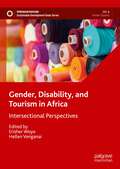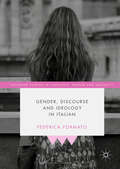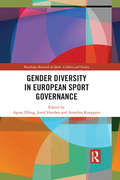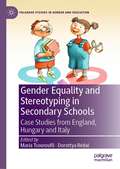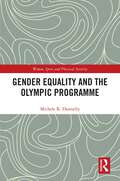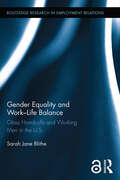- Table View
- List View
Gender Designs IT: Construction and Deconstruction of Information Society Technology (Studien Interdisziplinäre Geschlechterforschung)
by Heidi Schelhowe Isabel Zorn Susanne Maass Els Rommes Carola SchirmerHow can information technology (IT) paradigms and design processes be studied from a gender perspective? What does IT design look like when its construction is informed by gender research? Though gender research and computing science seem like two separate worlds, this book proves how inspirational a confrontation and combination of those worlds can be. A deconstructive analysis of advanced fields of computing shows the multiple ways in which software design is gendered and how gendering effects are produced by its use. Concepts and assumptions underlying research and development, along with design tools and IT products, teaching methods and materials are studied. The book not only offers a gender analysis of information society technologies, it also shows practical examples of how IT can be different. A gender perspective on IT design can serve as an eye-opener for what tends to be overlooked and left out. It yields innovative ideas and high quality software systems that may empower a large diversity of users for an active participation in our information society.
The gender dimension of social change: The contribution of dynamic research to the study of women's life courses
by Elisabetta Ruspini Angela DaleThe transformations that are now taking place in women's lives are of great interest to social scientists and policy makers, yet we know very little about the impact of this social change over time. This new study uses longitudinal data - information gathered over a considerable period of time - to provide new insights into the changing dynamics of lives of women today. In particular, it explores the potential of longitudinal or life course analysis as a powerful tool for appreciating the gender dimension of social life. The contributors view the data from a policy perspective and use comparative analysis from Britain, Germany, the Netherlands, Sweden and Japan to expand our understanding of women's life courses in relation to both men and women and the system of inequality.
Gender, Disability, and Tourism in Africa: Intersectional Perspectives (Sustainable Development Goals Series)
by Erisher Woyo Hellen VenganaiThis book explores the intersection of gender and disability in the context of tourism. In part, the book foregrounds feminist theorising of intersectionality by examining how gender can overlap with other social identities to contribute to more systemic oppression, domination, discrimination, and marginalisation of certain categories of people. Our point of departure is that disability does not operate in isolation as it is constituted and experienced within an already gendered social and tourism environment. With substantial research on the intersection of gender and tourism on the one hand, and the intersection of disability and tourism on the other hand, the interconnectedness of gender and disability and the implications this has on tourism policy and practice remains understudied. Thus, the book provides a critical lens that helps unpack underlying assumptions about gender and disability while questioning the dominant ideas about gender and disability reproduced through tourism policies and institutional practices in an African context. This book will be of interest to scholars and researchers in Gender Studies, Disability Studies, and Tourism Studies, particularly those with a research interest in Africa.
Gender, Discourse and Ideology in Italian (Palgrave Studies in Language, Gender and Sexuality)
by Federica FormatoThis book analyses gendered language in Italian, shedding light on how the Italian language constructs and reproduces the social imbalance between women and men, and presenting indirect and direct instances of asymmetrical constructions of gender in public and private roles. The author examines linguistic treatments of women in politics and the media, as well as the gendered crime of femminicidio, i.e. the killing of women by their (former) partners. Through the combination of corpus linguistics, surveys, and discourse analysis, she establishes a new approach to the study of gendered Italian, a framework which can be applied to other languages and epistemological sites. This book will be of particular interest to students and scholars of sociolinguistics, language and gender, discourse analysis, Italian and other Romance languages.
Gender, Discourse and Ideology in Italian (Palgrave Studies in Language, Gender and Sexuality)
by Federica FormatoThis book analyses gendered language in Italian, shedding light on how the Italian language constructs and reproduces the social imbalance between women and men, and presenting indirect and direct instances of asymmetrical constructions of gender in public and private roles. The author examines linguistic treatments of women in politics and the media, as well as the gendered crime of femminicidio, i.e. the killing of women by their (former) partners. Through the combination of corpus linguistics, surveys, and discourse analysis, she establishes a new approach to the study of gendered Italian, a framework which can be applied to other languages and epistemological sites. This book will be of particular interest to students and scholars of sociolinguistics, language and gender, discourse analysis, Italian and other Romance languages.
Gender, Displacement, and Cultural Networks of Galicia: 1800s to Present
by Obdulia Castro Diego Baena María A. Rey López Miriam Sánchez MoreirasThis book, bringing together a multi-voiced dialogue between academic scholars and professionals from diverse fields, shares a comprehensive and heterogeneous look at the interdisciplinarity of Galician Studies while examining a chronologically broad range of subjects from the 1800s to the present. This volume carves out a distinct approach to gender studies investigating issues of culture, language, displacement, counterculture artists, and community projects as related to questions of politics, gender and class. Women, conceived as both individual and political bodies, are studied, among other things, as an example of what it means to struggle from the margins emphasizing the importance of looking at the opposition between the center and the peripheries when studying the relationship between space and culture.
Gender Diversity and Inclusion at Work: Divergent Views from Turkey (Routledge Focus on Business and Management)
by Zeynep Özsoy Mustafa Şenyücel Beyza ObaThe purpose of this book is to investigate gender diversity practices and discourse developed by listed companies in Turkey. It pursues this aim by advancing knowledge about business relations affecting workplace gender diversity. The research builds on Bourdieu’s field approach and implements a Thematic Analysis following Braun and Clarke’s (2006) guidelines. The findings of the book are based on data collected from unstructured interviews and secondary sources such as the official documents of national and international organizations, newspapers, legislation, and web pages of the related parties. The findings suggest that the implementation of gender diversity practices may require a transformation of perspective and the conditions regarding the political, economic, and cultural realm for realization of a pervasive movement. Due to the conservative and patriarchal culture, authoritarian rule and neoliberal policies, gender diversity and inclusion are not seen as issues that should be resolved through the commitment and collaboration of a field. Consequently, diversity management practices are instrumentalized by the business community as a means for corporate communication and image building rather than actively building a diverse workforce.
Gender Diversity and Inclusion at Work: Divergent Views from Turkey (Routledge Focus on Business and Management)
by Zeynep Özsoy Mustafa Şenyücel Beyza ObaThe purpose of this book is to investigate gender diversity practices and discourse developed by listed companies in Turkey. It pursues this aim by advancing knowledge about business relations affecting workplace gender diversity. The research builds on Bourdieu’s field approach and implements a Thematic Analysis following Braun and Clarke’s (2006) guidelines. The findings of the book are based on data collected from unstructured interviews and secondary sources such as the official documents of national and international organizations, newspapers, legislation, and web pages of the related parties. The findings suggest that the implementation of gender diversity practices may require a transformation of perspective and the conditions regarding the political, economic, and cultural realm for realization of a pervasive movement. Due to the conservative and patriarchal culture, authoritarian rule and neoliberal policies, gender diversity and inclusion are not seen as issues that should be resolved through the commitment and collaboration of a field. Consequently, diversity management practices are instrumentalized by the business community as a means for corporate communication and image building rather than actively building a diverse workforce.
Gender Diversity and LGBTQ Inclusion in K-12 Schools: A Guide to Supporting Students, Changing Lives
by Sharon Verner Chappell Karyl E. Ketchum Lisa RichardsonThis exploration of effective practices to support lesbian, gay, bisexual, transgender, queer (LGBTQ) and gender-diverse students in elementary, middle, and high school contexts focuses on curriculum, pedagogy, and school environment. Narratives and artwork from the field are framed by sociocultural and critical theory as well as research-based elaboration on the issues discussed. Applications of antidiscrimination law and policy, as well as learning skills like creativity, collaboration, and critical thinking help teachers tackle some of the most significant educational challenges of our time. The stories of real-world practices offer encouragement for building inclusive environments and enhancing social-emotional relationships among youth, families, and schools. Gender Diversity and LGBTQ Inclusion in K-12 Schools provides a helpful roadmap for educators hoping to create safe and empowering spaces for LGBTQ and gender-diverse students and families.
Gender Diversity and LGBTQ Inclusion in K-12 Schools: A Guide to Supporting Students, Changing Lives
by Sharon Verner Chappell Karyl E. Ketchum Lisa RichardsonThis exploration of effective practices to support lesbian, gay, bisexual, transgender, queer (LGBTQ) and gender-diverse students in elementary, middle, and high school contexts focuses on curriculum, pedagogy, and school environment. Narratives and artwork from the field are framed by sociocultural and critical theory as well as research-based elaboration on the issues discussed. Applications of antidiscrimination law and policy, as well as learning skills like creativity, collaboration, and critical thinking help teachers tackle some of the most significant educational challenges of our time. The stories of real-world practices offer encouragement for building inclusive environments and enhancing social-emotional relationships among youth, families, and schools. Gender Diversity and LGBTQ Inclusion in K-12 Schools provides a helpful roadmap for educators hoping to create safe and empowering spaces for LGBTQ and gender-diverse students and families.
Gender Diversity in European Sport Governance (Routledge Research in Sport, Culture and Society)
by Agnes Elling Jorid Hovden Annelies KnoppersGender equality is one of the founding democratic principles of the EU. However, recent studies of the Federation of Olympic Sports in Europe have shown that women occupy only fourteen percent of decision-making positions in sport organizations. This book presents a comprehensive and comparative study of how various regions and countries of Europe have addressed this lack of gender diversity, discussing which strategies have brought about change and to what extent these changes have been successful. With contributions from leading sport sociologists, covering countries such as Germany, Hungary, Norway, Poland, Spain, Turkey and the UK, it provides a foundation for future policymaking, methodological analyses and theoretical developments that can result in sustainable gender equality in European sport governance. Gender Diversity in European Sport Governance is important reading for scholars and students in the fields of sociology of sport, sport management, sociology, gender studies and studies of organization, management and leadership. It is also a valuable resource for policy makers in the EU, as well as national sport organizations and activists.
Gender Diversity in European Sport Governance (Routledge Research in Sport, Culture and Society)
by Agnes Elling Jorid Hovden Annelies KnoppersGender equality is one of the founding democratic principles of the EU. However, recent studies of the Federation of Olympic Sports in Europe have shown that women occupy only fourteen percent of decision-making positions in sport organizations. This book presents a comprehensive and comparative study of how various regions and countries of Europe have addressed this lack of gender diversity, discussing which strategies have brought about change and to what extent these changes have been successful. With contributions from leading sport sociologists, covering countries such as Germany, Hungary, Norway, Poland, Spain, Turkey and the UK, it provides a foundation for future policymaking, methodological analyses and theoretical developments that can result in sustainable gender equality in European sport governance. Gender Diversity in European Sport Governance is important reading for scholars and students in the fields of sociology of sport, sport management, sociology, gender studies and studies of organization, management and leadership. It is also a valuable resource for policy makers in the EU, as well as national sport organizations and activists.
Gender Diversity in the Boardroom: Volume 1: The Use of Different Quota Regulations
by Cathrine Seierstad, Patricia Gabaldon and Heike Mensi-KlarbachThis edited collection provides a structured and in-depth analysis of the current use of quota strategies for resolving the pressing issue of gender inequality, and the lack of female representation on corporate boards. Filling the gap in existing literature on this topic, the two volumes of Gender Diversity in the Boardroom offers systematic overviews of current debates surrounding the optimisation of gender diversity, and the suggested pathways for progress. Focusing on sixteen European countries, the skilled contributors explore the current situation in relation to women on boards debates and approaches taken. They include detailed reflections from critical stakeholders, such as politicians, practitioners and policy-makers. Volume 1 focuses on eight European countries having adopted quotas and is a promising and highly valuable resource for academics, practitioners, policy makers and anyone interested in gender diversity because it examines and critiques the current corporate governance system and national strategies for increasing the share of women not only on boards, but within companies beyond the boardroom.
Gender Diversity, Recognition and Citizenship: Towards a Politics of Difference (Citizenship, Gender and Diversity)
by S. HinesThis book examines the meanings and significance of the UK Gender Recognition Act within the context of broader social, cultural, legal, political, theoretical and policy shifts concerning gender and sexual diversity, and addresses current debates about equality and diversity, citizenship and recognition across a range of disciplines.
Gender & Diversity Studies in MINT meets Naturwissenschaftsdidaktik: Synergien und Impulse für eine gender- & diversitätssensible Forschung und Lehre der Naturwissenschaften (Edition Fachdidaktiken)
by Martina Erlemann Sarah HuchGender und dessen Zusammenwirken mit weiteren Diversity-Dimensionen wie etwa soziale Herkunft, ein (zugeschriebener) Migrationshintergrund oder sexuelle Orientierung stehen an Hochschulen verstärkt im Fokus. Gefordert sind dabei auch gender- und diversitysensible Ausrichtungen der Forschung und Lehre der MINT-Fächer sowie der hochschulischen Lehramtsausbildung für MINT. Welche inhaltliche Relevanz haben Gender- und Diversity-Aspekte in Fachkultur, Forschungsinhalten sowie im Wissenschaftsverständnis der Naturwissenschaften? Wie strukturieren Geschlecht und andere soziale Differenzkategorien die Forschung? Wie kann eine Gender- und Diversity-Kompetenzen vermittelnde Lehrer*innenbildung aussehen?Auf diese Fragen geben die interdisziplinären Beiträge der Wissenschaftler*innen, etwa aus Physik, Biologie, Medizin, Feminist Science & Technology Studies sowie die naturwissenschaftlichen Fachdidaktiken Antworten. Ansätze sowie Wissensbestände der Gender & Diversity Studies in MINT werden mit den gender- und diversityausgerichteten Naturwissenschaftsdidaktiken zusammengeführt. Mit vielfältigen Anregungen ermutigen sie zu einer gender- und diversityorientierten Ausrichtung der (eigenen) Forschung und Lehre.
Gender, Embodiment and Fluidity in Organization and Management (Routledge Focus on Women Writers in Organization Studies)
by Robert McMurray Alison PullenThis third volume in the Routledge Focus on Women Writers in Organization Studies series challenges us to think again about the implications of gender, embodiment and fluidity for organizing and managing. The themes of this book disrupt our understanding of dualisms between sex (men and women), gender (masculinity and femininity) and mind / body, and in so doing analyze the ways in which dominant power relations constitute heteronormativity throughout organizational history, thereby reinforcing mainstream management research and teaching. By centring the work of women writers, this book gives recognition to their thinking and praxis; each writer making political inroads into changing the lived experiences of those who have suffered discrimination, exclusion and marginalization as they consider the ways in which organizational knowledge has tended to privilege rather than problematize masculinity, fixity, control, normativity, violence and discrimination. The themes and authors (Acker, de Beauvoir, Halberstam, Kosofsky Sedgwick, Kristeva, Yourcenar) covered in this book are important precisely because they are not generally encountered in mainstream writing on management and organization studies. They are significant to the study and analysis of organizations because they demonstrate how our understanding of managing and organizing can be transformed when other voices/bodies/genders write on what it is work, live, lead and relate to self and others. All the writers turn to the ways in which individuals matter organizationally, acknowledging that lived experiences are a source of political and ethical practice. Each Woman Writer is introduced and analyzed by experts in organization studies. Further reading and accessible resources are also identified for those interested in knowing more. This book will be relevant to students, researchers and practitioners with an interest in business and management, organizational studies, critical management studies, gender studies and sociology. Like all the books in this series, it will also be of interest to anyone who wants to see, think and act differently.
Gender, Embodiment and Fluidity in Organization and Management (Routledge Focus on Women Writers in Organization Studies)
by Robert McMurray Alison PullenThis third volume in the Routledge Focus on Women Writers in Organization Studies series challenges us to think again about the implications of gender, embodiment and fluidity for organizing and managing. The themes of this book disrupt our understanding of dualisms between sex (men and women), gender (masculinity and femininity) and mind / body, and in so doing analyze the ways in which dominant power relations constitute heteronormativity throughout organizational history, thereby reinforcing mainstream management research and teaching. By centring the work of women writers, this book gives recognition to their thinking and praxis; each writer making political inroads into changing the lived experiences of those who have suffered discrimination, exclusion and marginalization as they consider the ways in which organizational knowledge has tended to privilege rather than problematize masculinity, fixity, control, normativity, violence and discrimination. The themes and authors (Acker, de Beauvoir, Halberstam, Kosofsky Sedgwick, Kristeva, Yourcenar) covered in this book are important precisely because they are not generally encountered in mainstream writing on management and organization studies. They are significant to the study and analysis of organizations because they demonstrate how our understanding of managing and organizing can be transformed when other voices/bodies/genders write on what it is work, live, lead and relate to self and others. All the writers turn to the ways in which individuals matter organizationally, acknowledging that lived experiences are a source of political and ethical practice. Each Woman Writer is introduced and analyzed by experts in organization studies. Further reading and accessible resources are also identified for those interested in knowing more. This book will be relevant to students, researchers and practitioners with an interest in business and management, organizational studies, critical management studies, gender studies and sociology. Like all the books in this series, it will also be of interest to anyone who wants to see, think and act differently.
Gender, Empire, and Postcolony: Luso-Afro-Brazilian Intersections
by Anna M. KlobuckaAnalyzing a wide body of cultural texts, including literature, film, and other visual arts, Gender, Empire, and Postcolony: Luso-Afro-Brazilian Intersections is a diverse collection of essays on gender in Portuguese colonialism and Lusophone postcolonialism.
Gender Epistemologies and Eurasian Borderlands (Comparative Feminist Studies)
by M. TlostanovaTlostanova examines Central Asia and the Caucasus to trace the genealogy of feminism in those regions following the dissolution of the USSR. The forms it takes resist interpretation through the lenses of Western feminist theory and woman of color feminism, hence Eurasian borderland feminism must chart a third path.
Gender Epistemologies in Africa: Gendering Traditions, Spaces, Social Institutions, and Identities
by O. OyewumiThis volume brings together a variety of studies that are engaged with notions of gender in different African localities, institutions and historical time periods. The objective is to expand empirical and theoretical studies that take seriously the idea that in order to understand gender and gender relations in Africa, we must start with Africa.
Gender Equality and Inequality in Rural India: Blessed with a Son
by C. VlassoffAs India strives to improve overall social and economic conditions and gender relations through policies such as the abolishment of dowry, increasing the legal age at marriage, and promoting educational opportunities for girls, serious challenges remain, especially in rural areas. Gender Equality and Inequality in Rural India focuses on the extent to which economic development has resulted in positive changes in women's empowerment and reproductive health, as well as in sex preference. Based on a study from a village in Maharashtra where impressive gains in economic development have occurred in recent decades, Carol Vlassoff examines the impact of son preference on fertility and rural women's economic empowerment and other aspects of reproductive behavior. She provides evidence of the added value of their employment beyond the traditional wage labor and domestic spheres, and argues that policies aimed at closing gender gaps in social inequalities must be complemented by policies fostering employment opportunities for women. While many studies have demonstrated the importance of social empowerment for improved reproductive health, this is the first to separate out the differential effects of social and economic factors. This work goes even further than economic arguments by demonstrating, on the basis of a robust statistical analysis, that women's education and their professional labor force participation contribute to better health and wellbeing of rural society, including through reductions in fertility, son preference, and infant and child mortality.
Gender Equality and Stereotyping in Secondary Schools: Case Studies from England, Hungary and Italy (Palgrave Studies in Gender and Education)
by Maria Tsouroufli Dorottya RédaiThis book explores gender stereotyping and gender inequalities in secondary education in England, Hungary and Italy. The authors highlight the importance of addressing student and teacher attitudes if long-term changes in mindset are desired, as well as the underlying stereotypes that persist and linger in these educational contexts. Promoting a whole-school culture change approach, this book explores views of gender stereotypes from teachers and students concerning subject and career choices, as well as collaborative work with teachers, experts and NGOs in implementing and evaluating gender equality charters. Drawing on extensive research, this book employs an intersectional and cross-country approach: while the authors acknowledge the challenges and opportunities of researching gender equality frameworks across different countries, ultimately these link to the UN Sustainable Development goal of gender equality.
Gender Equality and the Olympic Programme (Women, Sport and Physical Activity)
by Michele K. DonnellyThis innovative study examines the Olympic programme from a critical feminist perspective, to shed new light on the issues of gender and inclusion at the Olympic Games and in the Olympic Movement. Incorporating both quantitative and qualitative data, the book identifies and analyzes the changes – and remaining gender differences – made on the Olympic Programmes for London 2012, and each of the subsequent Summer and Winter Olympic Games (Sochi 2014, Rio 2016, and Pyeongchang 2018), as well as the Tokyo 2020 and Beijing 2022 Games. The book draws on the IOC&’s own publications, information from International and National Sport Federations, and media sources to describe and explain the IOC&’s slow and uneven progress toward gender equality at the Olympic Games. This is important reading for any student, researcher, practitioner or policy maker with an interest in the Olympic Games, sport studies, gender studies, women&’s sport or major events.
Gender Equality and the Olympic Programme (Women, Sport and Physical Activity)
by Michele K. DonnellyThis innovative study examines the Olympic programme from a critical feminist perspective, to shed new light on the issues of gender and inclusion at the Olympic Games and in the Olympic Movement. Incorporating both quantitative and qualitative data, the book identifies and analyzes the changes – and remaining gender differences – made on the Olympic Programmes for London 2012, and each of the subsequent Summer and Winter Olympic Games (Sochi 2014, Rio 2016, and Pyeongchang 2018), as well as the Tokyo 2020 and Beijing 2022 Games. The book draws on the IOC&’s own publications, information from International and National Sport Federations, and media sources to describe and explain the IOC&’s slow and uneven progress toward gender equality at the Olympic Games. This is important reading for any student, researcher, practitioner or policy maker with an interest in the Olympic Games, sport studies, gender studies, women&’s sport or major events.
Gender Equality and Work-Life Balance: Glass Handcuffs and Working Men in the U.S. (Routledge Research in Employment Relations)
by Sarah BlithePressure to achieve work-life "balance" has recently become a significant part of the cultural fabric of working life in United States. A very few privileged employees tout their ability to find balance between their careers and the rest of their lives, but most employees face considerable organizational and economic constraints which hamper their ability to maintain a reasonable "balance" between paid work and other life aspects—and it is not only women who struggle. Increasingly men find it difficult to "do it all." Women have long noted the near impossibility of balancing multiple roles, but it is only recently that men have been encouraged to see themselves beyond their breadwinner selves. Gender Equality and Work-Life Balance describes the work-life practices of men in the United States. The purpose is to increase gender equality at work for all employees. With a focus on leave policy inequalities, this book argues that men experience a phenomenon called "the glass handcuffs," which prevents them from leaving work to participate fully in their families, homes, and other life events, highlighting the cultural, institutional, organizational, and occupational conditions which make gender equality in work-life policy usage difficult. This social justice book ultimately draws conclusions about how to minimize inequalities at work. Gender Equality and Work-Life Balance is unique as it laces together some theoretical concepts which have little previous association, including entrepreneurialism; leave policy, occupational identity, and the economic necessities of families. This book will therefore be of particular interest to researches and academics alike in the disciplines of Gender studies, Human Resource Management, Employment Relations, Sociology and Cultural Studies.


